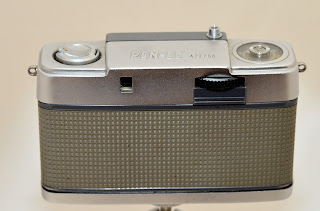The specifications for the PEN EE
Introduced 1961
Lens 2.8 cm f/3.5 D. Zuiko. It takes 43.5mm screw-in filters.
Aperture f/3.5 - f/22
Shutter speed 1/40 and 1/200 sec auto-selected.
ASA settings - 10, 25, 32,50, 64, 80, 100, 160, 200
Focus - Fixed
Weight - 12.5 ounces (350 gm)
Flash - PC connector for flash, no built-in flash shoe, but a screw-on flash bracket attaches via the tripod socket.
Manual is available at Butkus.org
 |
| flash bracket attached with tiny flash unit |
There's lots of information about the PEN series via the web, so I'm not going to reiterate what's already been put out there. My first foray into half-frame cameras took place over 15 years ago, when I purchased a PEN D, which was a lovely little rangefinder half-frame camera that was built like a tiny tank. I shot a few rolls of film with it, and it sat in a drawer until I sold it a few years later. I had other cameras that I shot with far more, and I didn't appreciate the camera as much as I should have. Since then, a few other half-frame cameras have come my way, such as the Konica EYE and its Soviet-era copy, the Micron, as well as a Canon Demi S (which I have yet to shoot). Then, this PEN EE recently came my way, and I knew that I had to test it out.
 |
| Not much smaller than the Olympus Trip 35! |
While the PEN EE is small, it's not a whole lot smaller than my Olympus Trip 35, which works pretty much the same as the PEN EE. The Trip 35 however, is full-frame, and is manually focused. The PEN EE is tiny enough to fit in a shirt pocket though, and is pretty much as point and shoot as you can get. I only have to set the ASA (ISO) to the proper film speed. I have kept in one of my camera bags and taken it out on various short outings to see how it performs with a roll of Eastman 5222 (Double-X), which is a 200 ISO black and white film.
The PEN EE selenium cell that surrounds the lens provides the metering and power for the exposure system. In dim light, the shutter defaults to 1/40 sec, with the apertures ranging from f/3.5 to f/8, and in brighter conditions, 1/200 sec from f/4.5 to f/22. So, for a 200 ISO film, pretty much any normal situation. I did test out a flash, which the camera sets the shutter speed at 1/40 sec. The flash result seemed pretty satisfactory.
Overall, the PEN EE is easy to use, as you might imagine. Note that in half-frame cameras, the vertical (portrait) orientation is the default, and you must turn the camera 90° for horizontal (landscape) shots.
Here are a series of scans from the Eastman 5222 film. It was developed in D-76, diluted 1:1 for 7.5 minutes. I think that with half-frame, it is best to shoot as fine-grained a film as possible, and there are slower films such as T-max 100 that would be perfect for this camera. The negatives were scanned on my Epson V700 scanner.
 |
| indoors with window light |
 |
| drive-by shooting |
 |
| indoors with ambient light |
 |
| with external flash unit |
 |
| Marshall, NC |
 |
| Marshall, NC |
 |
| Marshall, NC |
 |
| French Broad River, Asheville, NC |
 |
| French Broad River, Asheville, NC |
 |
| French Broad River, Asheville, NC |
Does the PEN EE live up to the idea that a camera could be as easy to use and ubiquitous as a pen? It pretty much does. Before the age of smartphones and tiny digital p&s cameras, the PEN cameras would have been great to always have with you. Yes, the Rollei 35 was about the same size, but it is fiddly compared to the PEN EE. The PEN EE and EES (pretty much the same, but with adjustable focus and and an f/2.8 lens) would have been easily carried along, ready for a snap on a moment's notice. However, I think that you really have to have a mindset that half-frame is right for you. For me, it's a curiosity to play with, and as I noted earlier, my Olympus Trip 35 is full-frame, and gives me results that I am happy with. I am not knocking the cameras -- they are wonderful gems. I just am not the happy half-framer! I think that if you want full-frame with a camera even smaller than the pen, the Olympus XA series is exactly fitting in with the idea of the PEN.





1 comment:
Nice review, Mark! I got an Olympus Pen EES-2 which I like a lot. It's basically the Trip in half-frame format.
One question: What Pens were rangefinders? As far as I can find out, Olympus never made a Pen rangefinder. The Pen D series is rangefinder-esque with manual focus and exposure control, but lacks an actual rangefinder. It's just viewfinder with zone focus. It's interesting to think that Olympus actually made a half-frame SLR in the F series, but everything else was simply a viewfinder.
I also have a Pen D on the way. I'm eager to try that one out!
-Shawn
https://urbanadventureleague.wordpress.com/landing-page/
Post a Comment